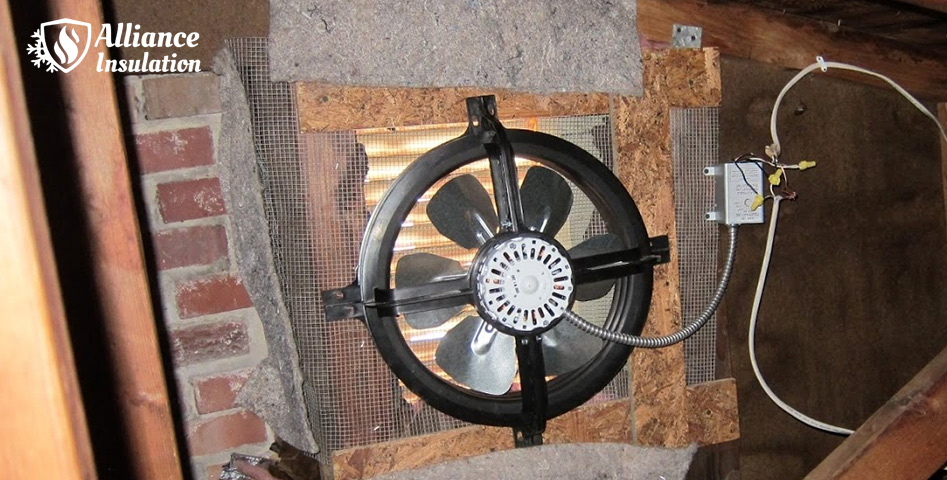
Attic Fan Installation in Los Angeles
Attic fan installation in Los Angeles offers numerous advantages for homeowners. These fans help regulate temperature by drawing hot air out of the attic, reducing the strain on cooling systems and potentially lowering energy costs. They also prevent the build-up of moisture, which can lead to mold and other structural issues
However, attic fan installation in Los Angeles is not devoid ofchallenges. Proper wiring, placement, and sizing are crucial for optimal performance, and inadequate installation may lead to inefficiency or even damage. We ensure that the work is done efficiently and by adhering to safety standards. Our team has the necessary knowledge, tools, and experience to navigate potential challenges, ensuring a well-functioning and reliable attic fan system.
Components of Attic Fan System
When you are looking forattic fan installation in Los Angeles, you need to know about the different components. An Attic Fan System system consists of several components that work together to ventilate and cool the attic space effectively. Here are the main components
Attic Fan
This is the central component of the system and is responsible for pulling hot air out of the attic and expelling it outside. The fan can be powered by electricity or solar energy.
Ventilation Ducts
These are the channels through which the hot air is extracted from the attic. They connect the fan to the outside, allowing for proper air circulation.
Intake Vents
These vents are strategically placed at the lower portion of the attic to draw in fresh air from outside. They facilitate the replacement of hot air with cooler air, ensuring efficient ventilation.
Thermostat
A thermostat is used to monitor the temperature in the attic. When the temperature exceeds a certain threshold, the thermostat triggers the fan to start, helping to maintain a comfortable and regulated environment.
Fan Controls
These controls allow you to adjust the speed and operation of the attic fan, giving you flexibility and control over the ventilation process.

The Different Types of Attic Fans that We Help You Install
As one of the most experienced names in attic fan installation in Los Angeles, we have experience in one of the most types of attic fan systems. Here are some of the common types of attic fan systems
| Attic Fan System | Description | Advantages |
|---|---|---|
| Roof-Mounted Attic Fans | These fans are installed on the roof of a building and are designed to draw hot air out of the attic space |
|
| Gable-Mounted Attic Fans | These fans are installed on the gable end of the attic and work by pulling hot air out of the attic space |
|
| Whole House Fans | These fans are typically installed in the ceiling of the top floor and work by pulling cool air from the living space into the attic and expelling hot air through vents or a separate attic fan. |
|
| Turbine Attic Ventilators | These passive systems utilize wind power to create ventilation in the attic. The spinning turbine vents help draw hot air out of the attic space. |
|
Our Services for Attic Fan Installation in Los Angeles
We offer a wide range of services for attic fan installation in Los Angeles. Here are some of the different services that our team offers
Attic Fan Installation
Install new attic fans in your home. Assess your attic space, recommend the appropriate size and type of fan, and ensure proper installation, including electrical connections.
Attic Fan Selection
There are various types of attic fans available, including roof-mounted fans, gable-mounted fans, and whole-house fans. Factors like the attic’s square footage, the home’s layout, and the climate are considered to recommend the best fan type.
Electrical Wiring and Installation
Our team will handle the electrical wiring and ensure that the fan is safely and correctly installed. All electrical codes and safety guidelines are followed to prevent any electrical hazards.
Roof or Gable Vent Modification
Depending on the type of attic fan chosen, we may need to modify existing roof vents or gable vents to accommodate the new fan installation.
Attic Fan Upgrades
You can enhance the performance of your attic fan by getting a recommendation and installing upgrades. This may involve installing a more powerful fan, adding a thermostat or humidistat for automatic control, or integrating the fan with your home’s automation system.
Attic Fan Ventilation Assessment
Assess your attic’s ventilation system to ensure proper airflow. Identify potential issues such as inadequate venting, insulation problems, or air leaks and suggest solutions to improve ventilation.
Energy Efficiency Consultation
Evaluate your attic fan’s energy usage and efficiency. Get recommendations on energy-saving options, such as installing a solar-powered attic fan or integrating the fan with a whole-house ventilation system.
Faq’s
In Los Angeles, the requirement for permits for attic fan installation can vary based on several factors, including the specific location, the type of attic fan being installed, and local building codes. Generally, if the installation involves electrical work or modifications to the building’s structure, permits will be required
There are two main types of attic fans: roof-mounted fans and gable-mounted fans. Roof-mounted fans are installed directly on the roof and are typically more efficient but require professional installation. Gable-mounted fans are installed on the gable wall of the attic and can be more accessible for DIY installation.
The size of the attic fan you need depends on the square footage of your attic. As a general rule of thumb, you should have one square foot of net free vent area (the combined area of all attic vents) for every 300 cubic feet per minute (CFM) of fan capacity. Consult a professional or follow the manufacturer’s recommendations for proper sizing.
Get a Free Quote


